
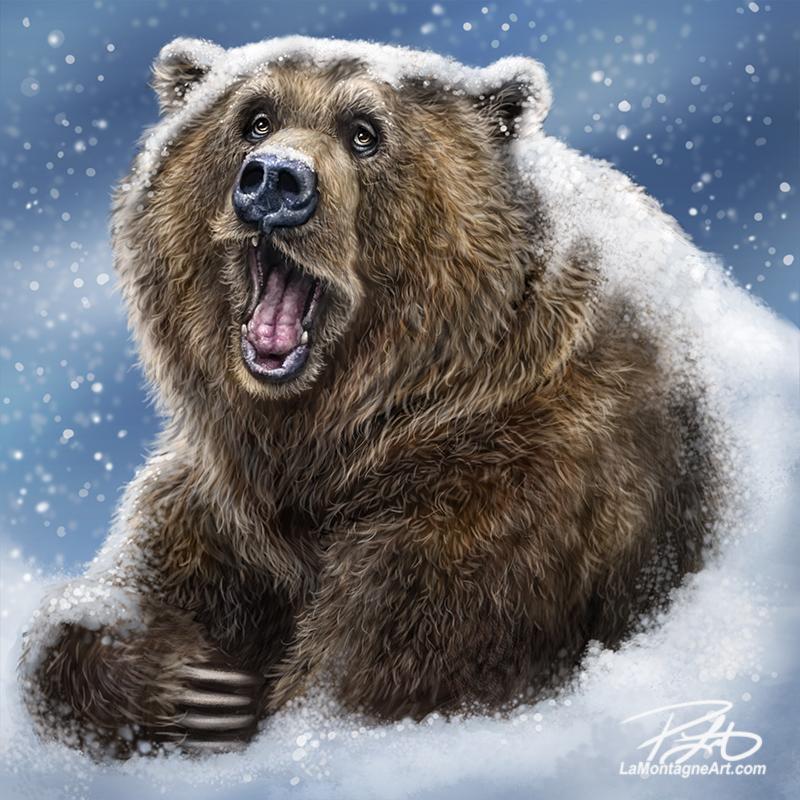 Because I haven’t released a new painting in a while, I did not want to publish yet another post promising something new down the road. So, here’s a new piece: a weary-looking grizzly bear in the snow. I’m calling it Bedtime.
Because I haven’t released a new painting in a while, I did not want to publish yet another post promising something new down the road. So, here’s a new piece: a weary-looking grizzly bear in the snow. I’m calling it Bedtime.
I had planned on sharing a different painting this week. Here’s why that changed.
Over the past twenty-plus years of my art career, both as a syndicated editorial cartoonist and a digital painter, there have been plenty of times when something I’ve drawn hasn’t worked out the way I had planned.
The beauty of digital drawing and painting is that it’s often easier to fix mistakes. I can create a new layer, play around and experiment; if I don’t like it, I delete it and try a different direction. Most creatives are familiar with happy accidents, something unexpected that improves an image. It happens all the time.
There’s always an element of discovery in any illustration or painting.
On the flip side, an image can sometimes become an exercise in frustration. Years ago, a bighorn sheep painting had me pulling out my hair. No matter what I did, I couldn’t get the curl of the horns to look right. They were either too flat, distorted, or just wrong, and every time I messed with them, I’d have to spend hours repainting the detailed texture I ruined.
It’s hardly a unique story. Every artist I know goes through this. For traditional artists who paint with oil, acrylic, watercolour or airbrush, it’s even worse. Sometimes, they try to fix something that isn’t working and get to a point where they’ve just ruined any chance of recovery. The canvas ends up in the trash, and they start over.
I began a painting of a group of Ring-tailed Lemurs months ago. I thought it would be finished this summer and again this week. I can’t begin to estimate how many hours I’ve spent on this painting. It has been one disappointment after another. But I finally got through the other work and deadlines holding up my progress and recently spent several mornings on it.
I was within what I thought was two or three hours of finishing, then realized I didn’t like it. That’s a hard truth to admit when I have invested so much time into a piece.
On my iPad, I took it to my buddy Derek at Electric Grizzly Tattoo. He’s a talented and skilled artist, and we sometimes ask each other for an unbiased eye. I can always count on his constructive criticism and willingness to help me produce a better piece of art. I do my best to return that generosity in kind, and when asked, offer my own thoughts on his paintings.
While Derek liked the individual faces, he agreed that the composition had problems. It was tough to hear, but it confirmed what I already knew.
After I got home, I spent a couple of hours messing with it, still trying to save it. But it was a gut-punch realization that I’d almost have to start from scratch. If I released the painting as is, knowing the obvious problems, even if others like it, I would hate it every time I looked at it.
So, while I’m not quite back at square one, it’s close. I’ve been sketching over the piece and trying new things, and I’m already much happier with the composition.
Reworking it, however, meant destroying what I had already painted. I must redo all the fur and hair, the detail in the muzzles and eyes, and add other elements that weren’t there before.
Whenever I finish the newer version, I will share more about this process, including what specifically I didn’t like and my thoughts on what I needed to change. I will also show you the piece I showed Derek and share why we both felt it didn’t work. But I don’t want to do that until I reveal the finished piece so you can see the comparison.
Anytime you do something creative, there’s a chance it won’t work. Authors have had to discard whole chapters and rehash plotlines when an editor has their way with a novel. Chefs have prepared complicated and ultimately inedible meals from experimental recipes. Filmmakers have spent years creating box office bombs.
As Benjamin Franklin said, “I didn’t fail the test; I just found 100 ways to do it wrong.”
If you’re not prepared to fail, you’ll never succeed.
So, I set the lemurs aside this week and began this bear piece on Tuesday as a palate cleanser before I jump back into the other works in progress I have yet to complete, including those lemurs.
Because when life hands you lemons, paint a grizzly bear.
That’s the saying, right?
Well, it works for me.
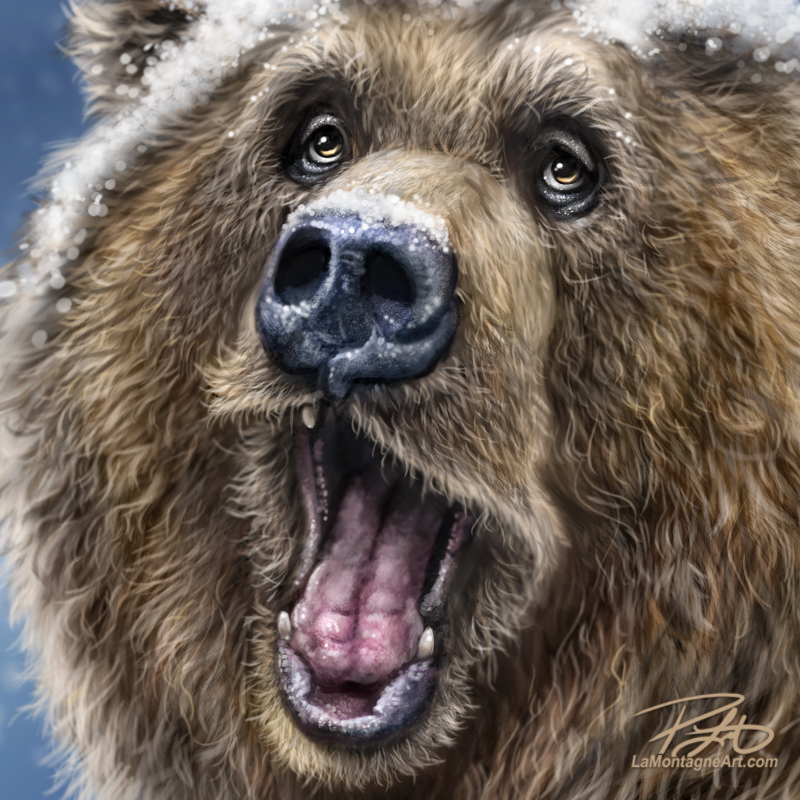
This Thursday, I’ll be one of 150 vendors setting up for the Banff Christmas Market. That evening, a locals’ preview event is already sold out. After that, from Friday to Sunday for the next four weeks, you’ll find me in my booth at the Banff Train Station, offering prints, calendars, coasters, magnets and stickers. Tickets are only available in advance on their website, and they go quickly, especially on Saturdays. I hope to see you there.
Thanks to so many of you who have purchased calendars already. I’ve been getting those orders out as soon as they come in, so if you’re waiting for yours, they’re on the way. If you still want one (or two, three, four…you get the idea), you can get them in the store while supplies last.

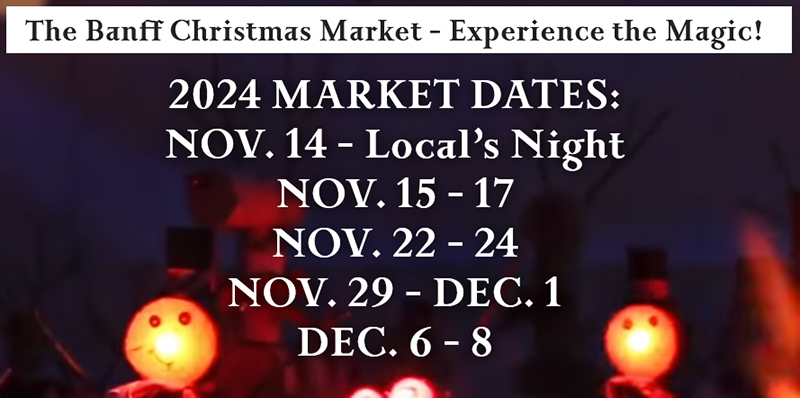
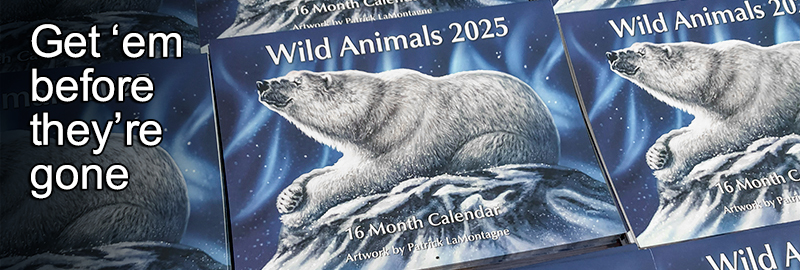

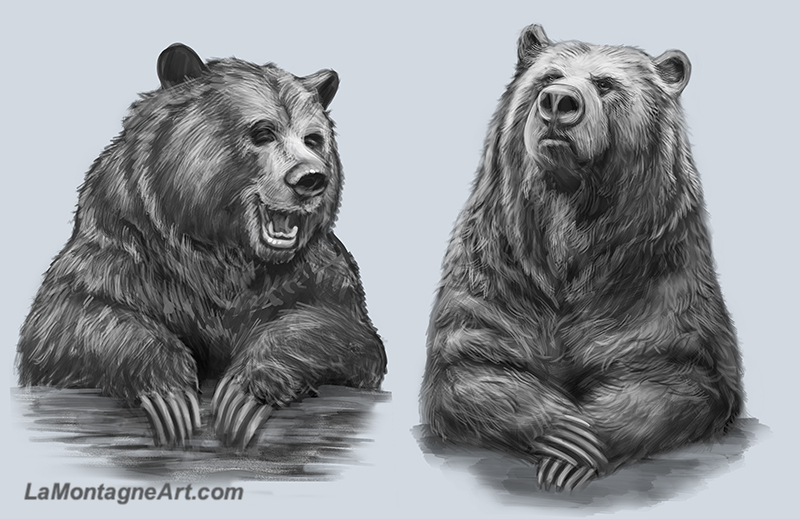 But I’ve also been working on the group of bears I’ve been chipping away at for some time now. The original plan for this piece was five adult bears sitting at a log in the woods, like a group of friends hanging out and chatting. I drew six of them separately to give myself options.
But I’ve also been working on the group of bears I’ve been chipping away at for some time now. The original plan for this piece was five adult bears sitting at a log in the woods, like a group of friends hanging out and chatting. I drew six of them separately to give myself options.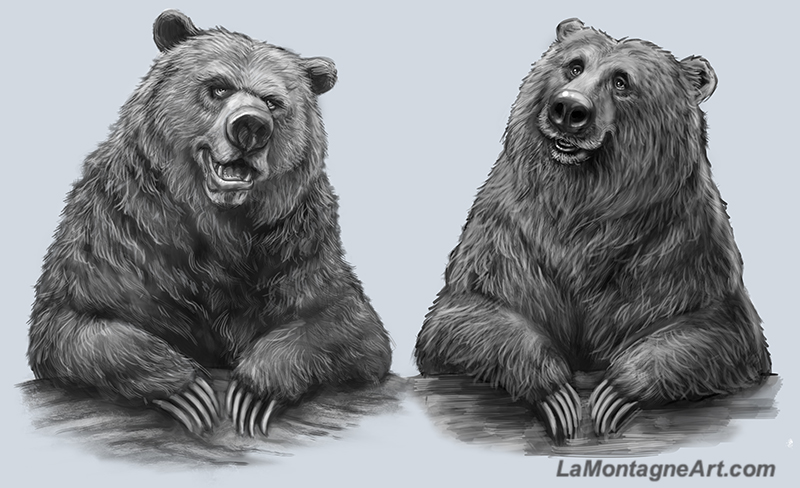 However, when I dropped and dragged them together into one image, the digital canvas was very long. A long horizontal canvas has appeal for a canvas or metal print. However, from a commercial perspective, it would limit what I could offer for licensing and paper prints.
However, when I dropped and dragged them together into one image, the digital canvas was very long. A long horizontal canvas has appeal for a canvas or metal print. However, from a commercial perspective, it would limit what I could offer for licensing and paper prints.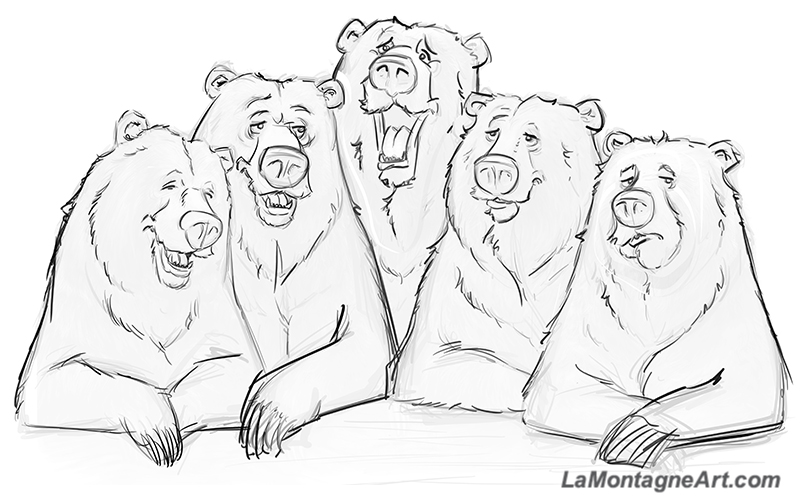 Once I was pleased with the group layout, I dropped the layer’s opacity and traced over the shapes and basic features. I did this several times, refining with each pass.
Once I was pleased with the group layout, I dropped the layer’s opacity and traced over the shapes and basic features. I did this several times, refining with each pass.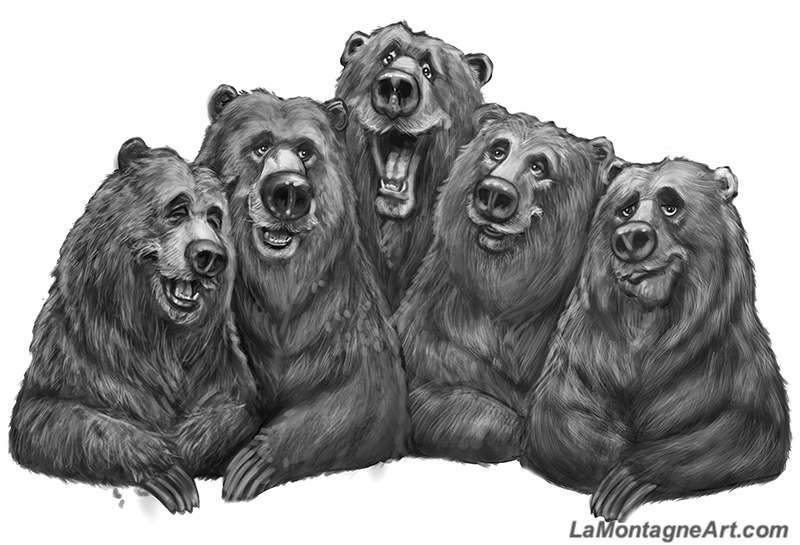 Then, I got to work on the shading, detail, expressions, and character. I do that right up until the end of every painting, as personality is the most essential part and is where I have the most fun. And with this painting, I’ve got five faces to discover instead of one.
Then, I got to work on the shading, detail, expressions, and character. I do that right up until the end of every painting, as personality is the most essential part and is where I have the most fun. And with this painting, I’ve got five faces to discover instead of one.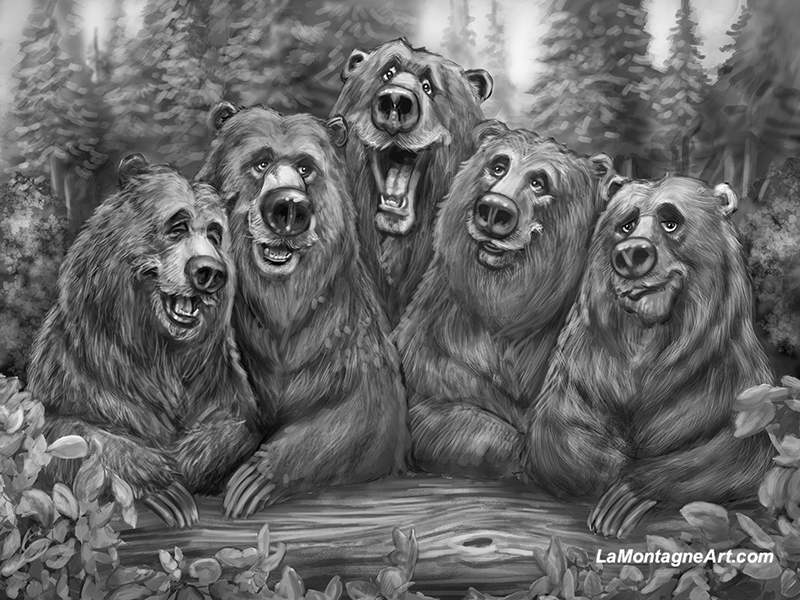 This piece seems like a family posing for a Sears portrait or the opening of a sitcom like Family Ties or Growing Pains. I’m going to call it ‘The Grizzlies.’
This piece seems like a family posing for a Sears portrait or the opening of a sitcom like Family Ties or Growing Pains. I’m going to call it ‘The Grizzlies.’

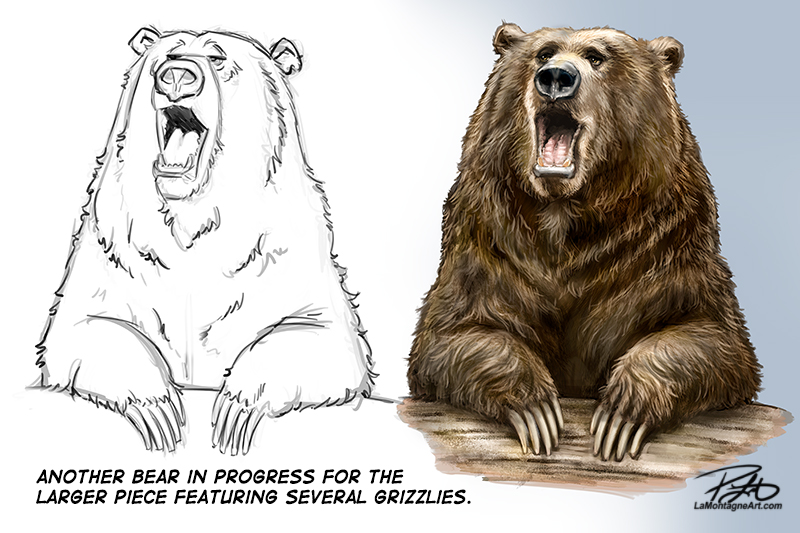 The paintings I was already working on need to be done by the end of next month so I can order puzzles and products for the markets. Then there are the sketches, paintings and writing for the book, six editorial
The paintings I was already working on need to be done by the end of next month so I can order puzzles and products for the markets. Then there are the sketches, paintings and writing for the book, six editorial 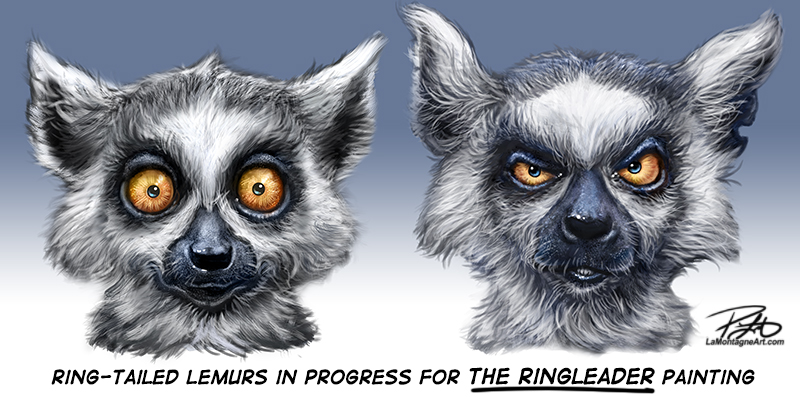 Sure, I’ll bitch about being too busy sometimes, but I chose this. Though the landscape will change, as will the work, and it’s unlikely ever to get easier, I plan to create art as long as possible. I don’t know if I could do anything else, now.
Sure, I’ll bitch about being too busy sometimes, but I chose this. Though the landscape will change, as will the work, and it’s unlikely ever to get easier, I plan to create art as long as possible. I don’t know if I could do anything else, now.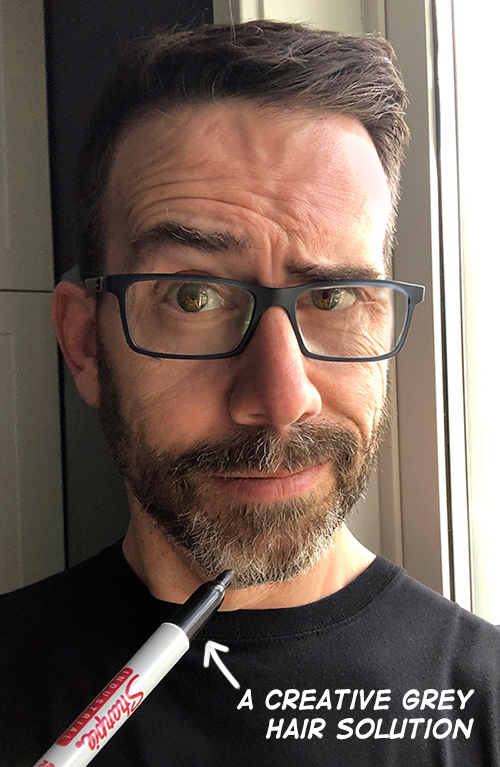 I’m grateful for so many of you who follow my work, comment on my posts or write emails, sending me wildlife pictures and thoughts about something I’ve shared or the artwork in general. With so much content available to us, that anyone volunteers to receive my
I’m grateful for so many of you who follow my work, comment on my posts or write emails, sending me wildlife pictures and thoughts about something I’ve shared or the artwork in general. With so much content available to us, that anyone volunteers to receive my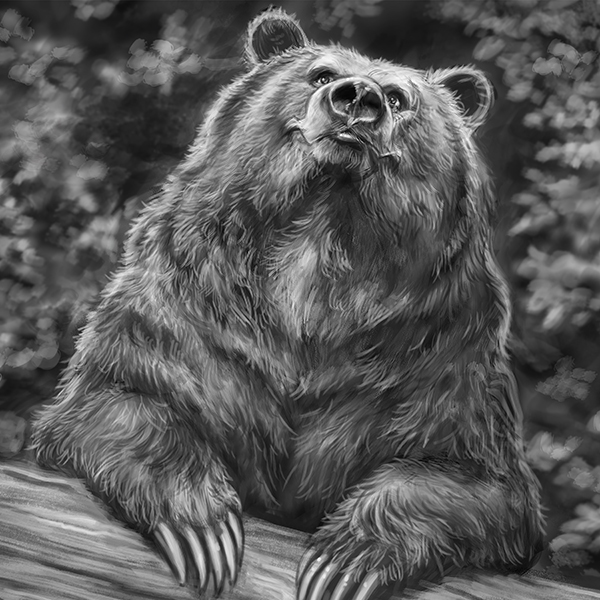
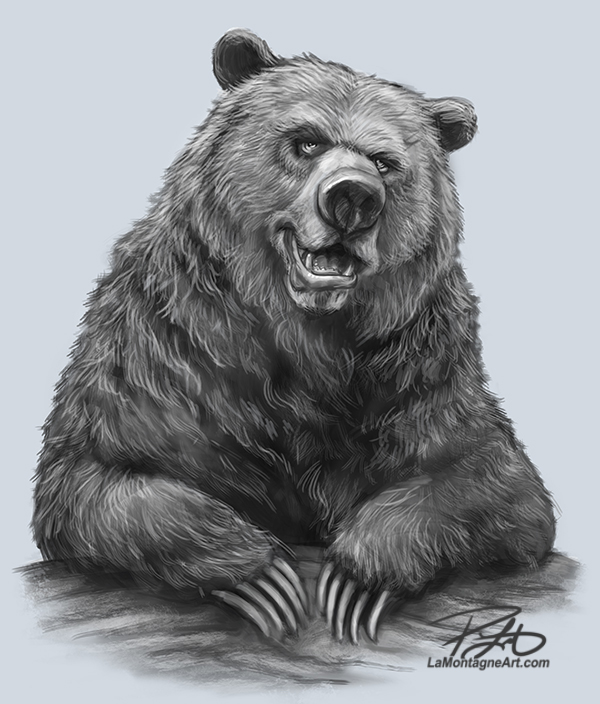 I rarely visit the
I rarely visit the 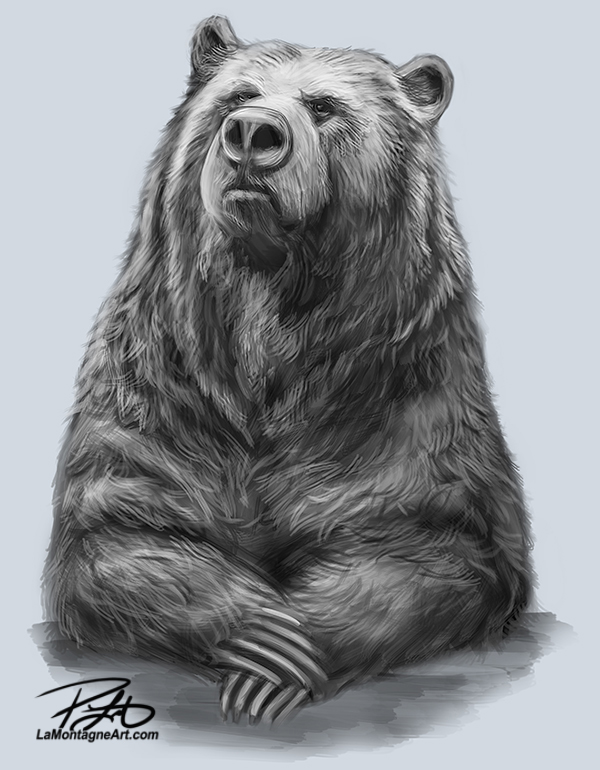 Parks Canada officials would have euthanized Bear #16 in 1996, but the Calgary Zoo had an opening, and he has lived there ever since. In the wild, a male grizzly doesn’t live far past his 20s. Skoki is now 37 years old. He is an old bear and looks it, but despite obvious age-related deficiencies, he’s healthy.
Parks Canada officials would have euthanized Bear #16 in 1996, but the Calgary Zoo had an opening, and he has lived there ever since. In the wild, a male grizzly doesn’t live far past his 20s. Skoki is now 37 years old. He is an old bear and looks it, but despite obvious age-related deficiencies, he’s healthy.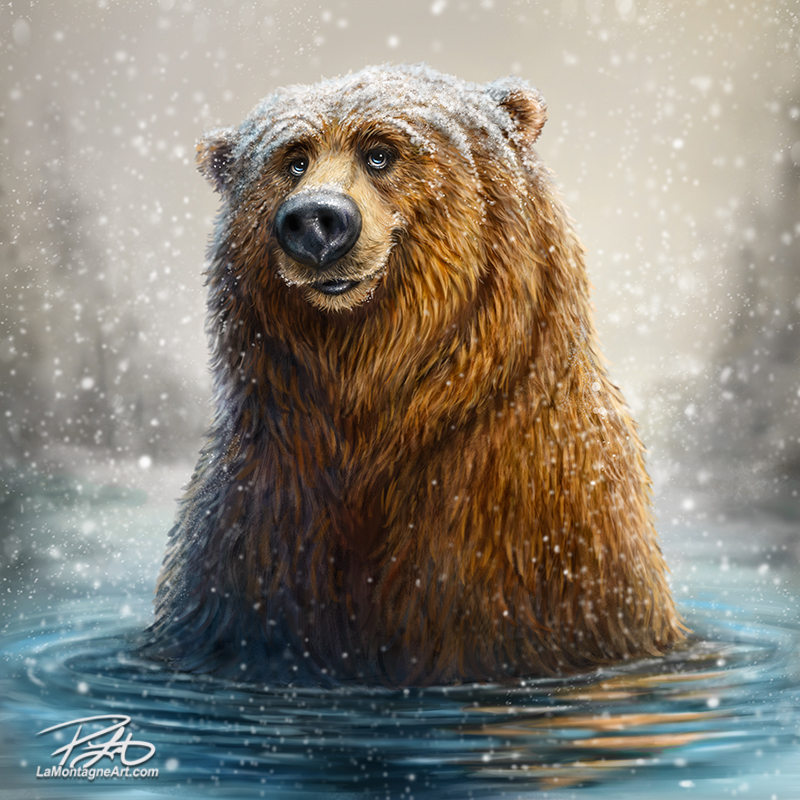
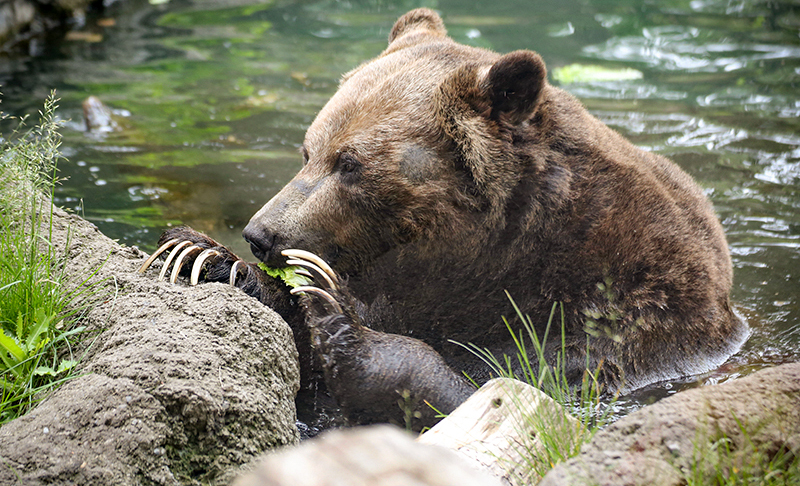 One day in June last year, after dropping off prints, I found Skoki active again. I followed him around his large enclosure until he did something I’d never seen before. He walked the length of a log until he came to a larger log that crossed it. He straddled the one on which he’d been walking and put his paws up on the crossed log. He looked like he’d just bellied up to the bar and was waiting for service.
One day in June last year, after dropping off prints, I found Skoki active again. I followed him around his large enclosure until he did something I’d never seen before. He walked the length of a log until he came to a larger log that crossed it. He straddled the one on which he’d been walking and put his paws up on the crossed log. He looked like he’d just bellied up to the bar and was waiting for service.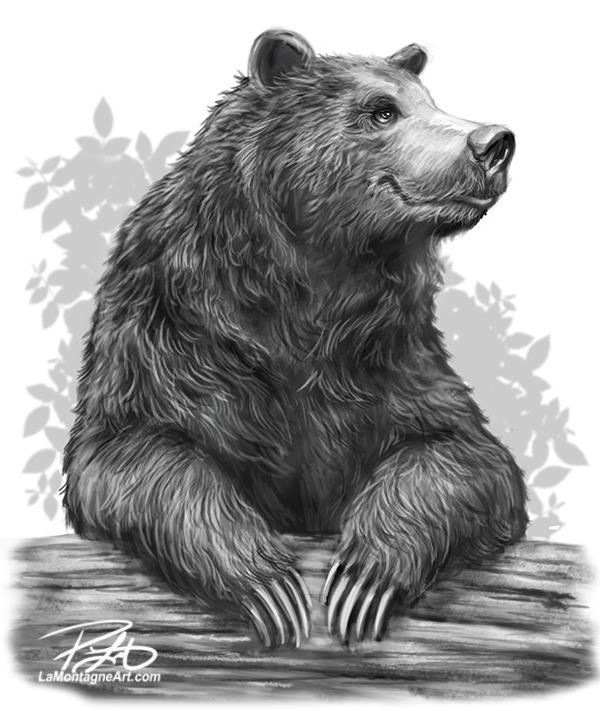 This painting has been rattling around in my noggin for quite a while, and I’ve drawn several sketches, including the ones in this post. All the reference I’m using for this work in progress is Skoki, but I’ll make the five bears different heights, weights and colour variations so they don’t all look like the same bear. Other photo references will help me do that, and I’m planning more sketches like these to explore my options.
This painting has been rattling around in my noggin for quite a while, and I’ve drawn several sketches, including the ones in this post. All the reference I’m using for this work in progress is Skoki, but I’ll make the five bears different heights, weights and colour variations so they don’t all look like the same bear. Other photo references will help me do that, and I’m planning more sketches like these to explore my options.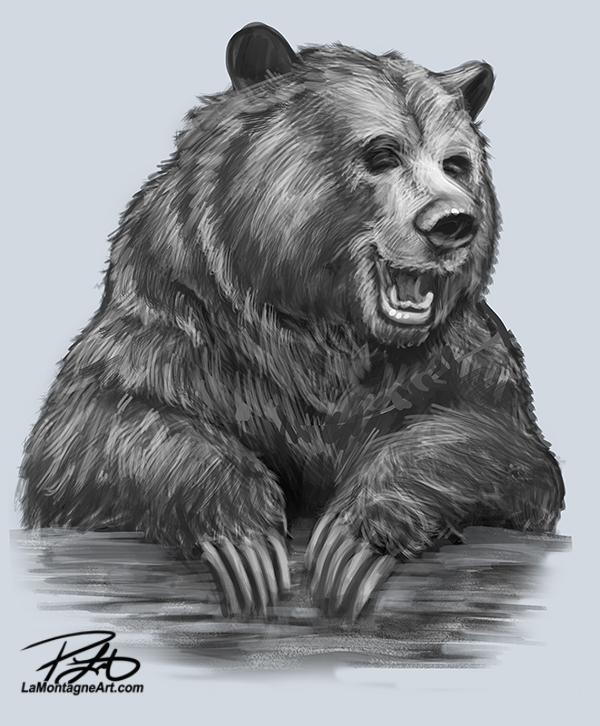 I started one of these Skoki sketches a little while ago and figured I’d try a full pose of how he sat that day. Before I knew it, I had drawn more detail and realized the image below was becoming its own painting.
I started one of these Skoki sketches a little while ago and figured I’d try a full pose of how he sat that day. Before I knew it, I had drawn more detail and realized the image below was becoming its own painting.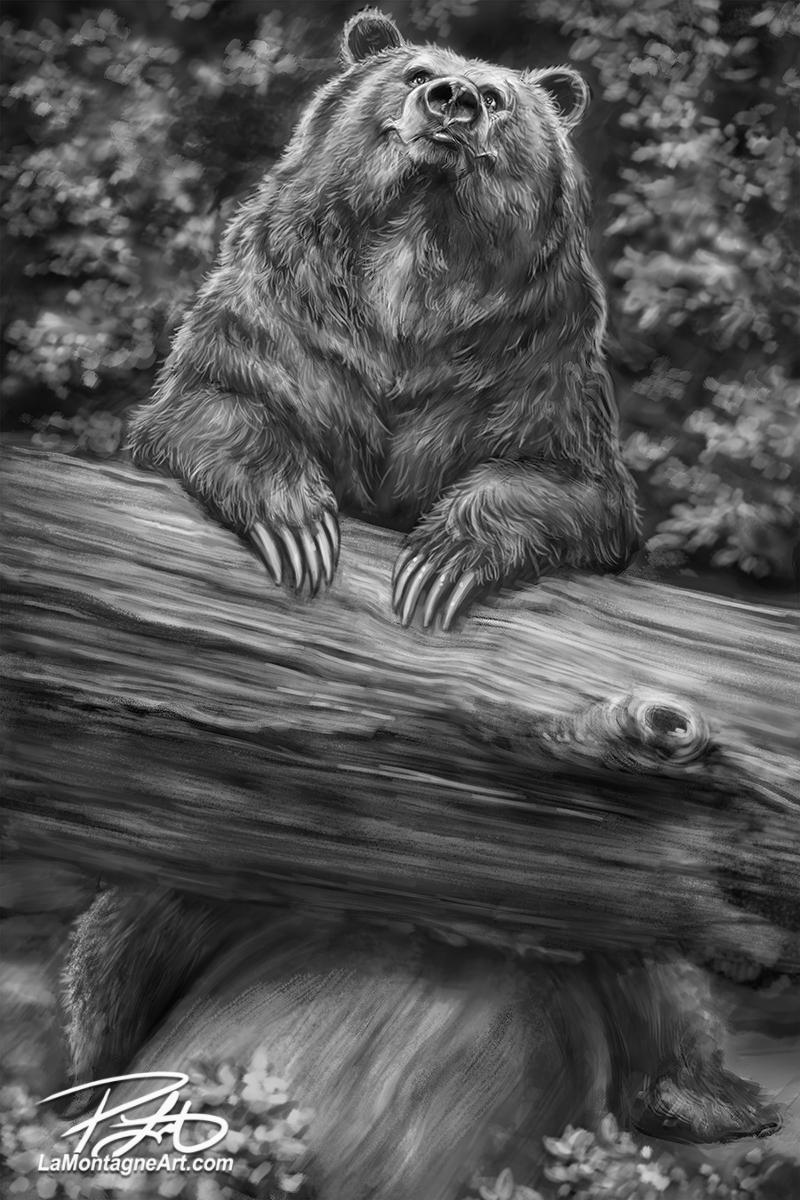 Because I don’t paint a lot of backgrounds in my work, I’ll often begin some paintings in grayscale so I can get the light, shadows and contrast right. Later, I can add colour using various techniques I’ve discovered in over twenty years of digital painting.
Because I don’t paint a lot of backgrounds in my work, I’ll often begin some paintings in grayscale so I can get the light, shadows and contrast right. Later, I can add colour using various techniques I’ve discovered in over twenty years of digital painting.
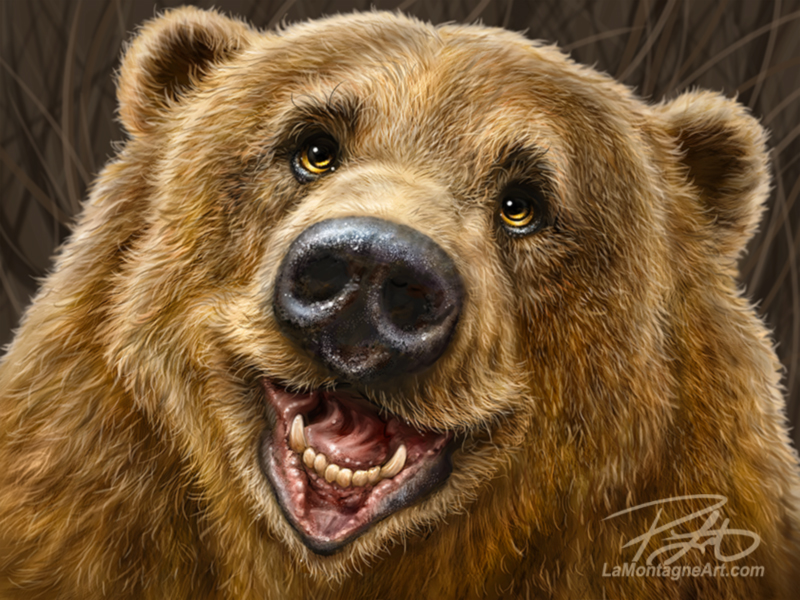 Winter reared its ugly head this week in Alberta, and I’m already feeling the blues. It happens every year, but painting a happy face usually puts me in a better mood. Grizzly Bearapy. It’s an effective prescription.
Winter reared its ugly head this week in Alberta, and I’m already feeling the blues. It happens every year, but painting a happy face usually puts me in a better mood. Grizzly Bearapy. It’s an effective prescription.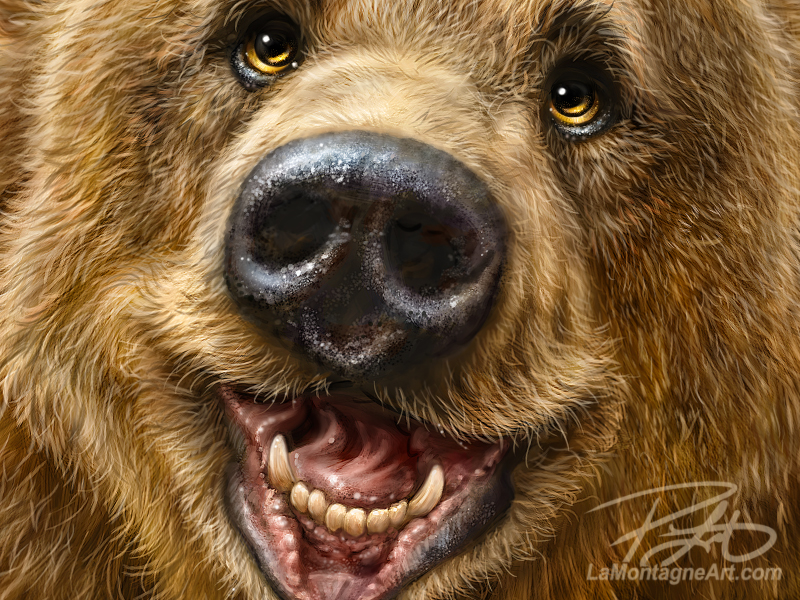 Though this painting was fun to do, as are most of my whimsical wildlife pieces, it was a commercial decision. It’s the first in a series of paintings I’m creating to promote my work to new licensing clients. It’s also another painting for the bear book.
Though this painting was fun to do, as are most of my whimsical wildlife pieces, it was a commercial decision. It’s the first in a series of paintings I’m creating to promote my work to new licensing clients. It’s also another painting for the bear book.

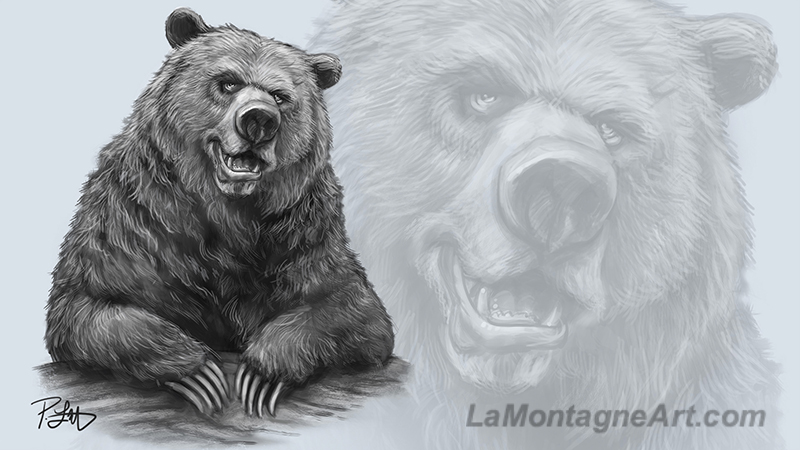 Parents used to tell their children to get an education and have something to fall back on, but those safety jobs have become rare. The days of thirty or forty years with a company followed by a healthy pension are long gone. We read daily about massive layoffs from corporations with names that used to be synonymous with stability.
Parents used to tell their children to get an education and have something to fall back on, but those safety jobs have become rare. The days of thirty or forty years with a company followed by a healthy pension are long gone. We read daily about massive layoffs from corporations with names that used to be synonymous with stability.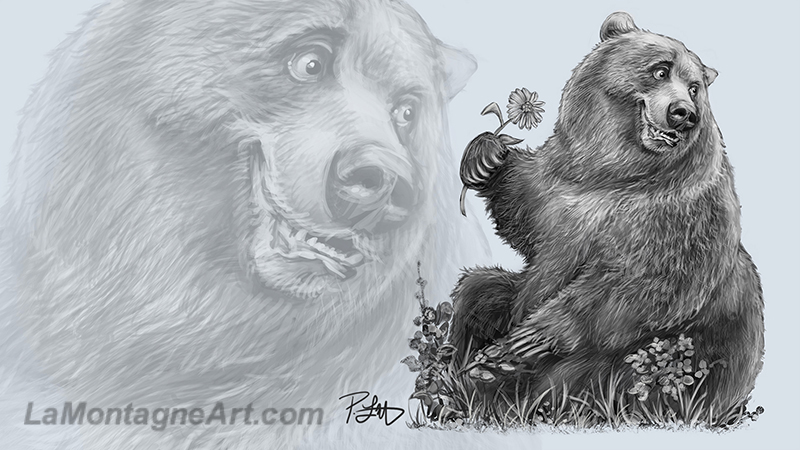 Several licensing companies rent the rights to put my work on their products. Occasionally, one will ask for a painting of a specific animal. If I can, I’ll try to accommodate the request. But without fail, as soon as I do, the client has a list of other images they want me to create.
Several licensing companies rent the rights to put my work on their products. Occasionally, one will ask for a painting of a specific animal. If I can, I’ll try to accommodate the request. But without fail, as soon as I do, the client has a list of other images they want me to create.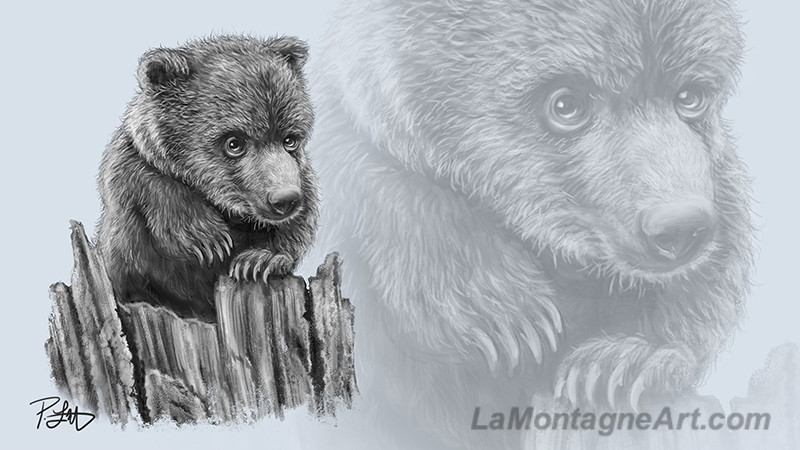 When companies are your clients, your needs are not their needs. If your art resonates with their customers, then it’s mutually beneficial. But the moment it doesn’t, you’re yesterday’s news. They’ll work with the artist who makes them the most money. They’re in business to promote their company, not your work.
When companies are your clients, your needs are not their needs. If your art resonates with their customers, then it’s mutually beneficial. But the moment it doesn’t, you’re yesterday’s news. They’ll work with the artist who makes them the most money. They’re in business to promote their company, not your work.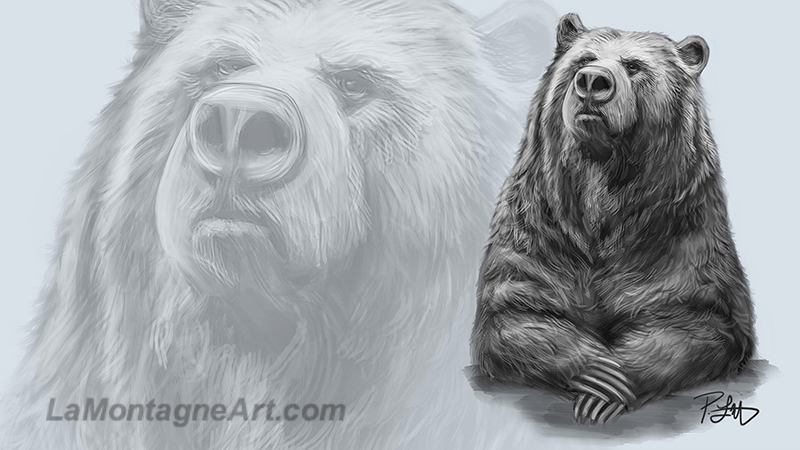 Customer service, professional behaviour and sound business practices are essential, as is compromise and accommodating your clients’ needs and wishes. People pay you to supply what they need, and delivering that often builds lasting relationships beneficial to both parties. All boats rise with the tide. Fail to realize these things, and you’ll soon be out of business.
Customer service, professional behaviour and sound business practices are essential, as is compromise and accommodating your clients’ needs and wishes. People pay you to supply what they need, and delivering that often builds lasting relationships beneficial to both parties. All boats rise with the tide. Fail to realize these things, and you’ll soon be out of business.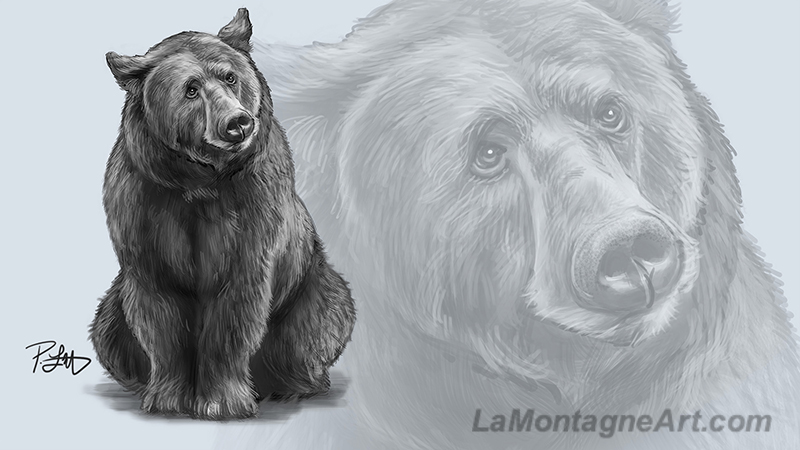 I enjoy creating my animal art, but lately, whenever I go to paint something, I think, “Will this animal be popular? Have I painted too many of these? Not enough? Will this make me any money?”
I enjoy creating my animal art, but lately, whenever I go to paint something, I think, “Will this animal be popular? Have I painted too many of these? Not enough? Will this make me any money?”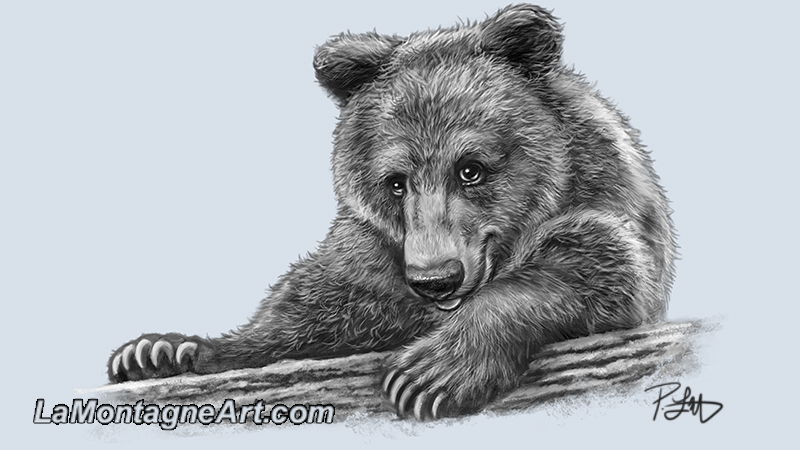 So while I’m trying to answer the question of what I want to do, I’m working on my art book about bears. Not promising to work on it like I’ve been doing for more than six years, but working on it, as I’m well and truly sick and tired of my own procrastination and bullshit excuses.
So while I’m trying to answer the question of what I want to do, I’m working on my art book about bears. Not promising to work on it like I’ve been doing for more than six years, but working on it, as I’m well and truly sick and tired of my own procrastination and bullshit excuses.
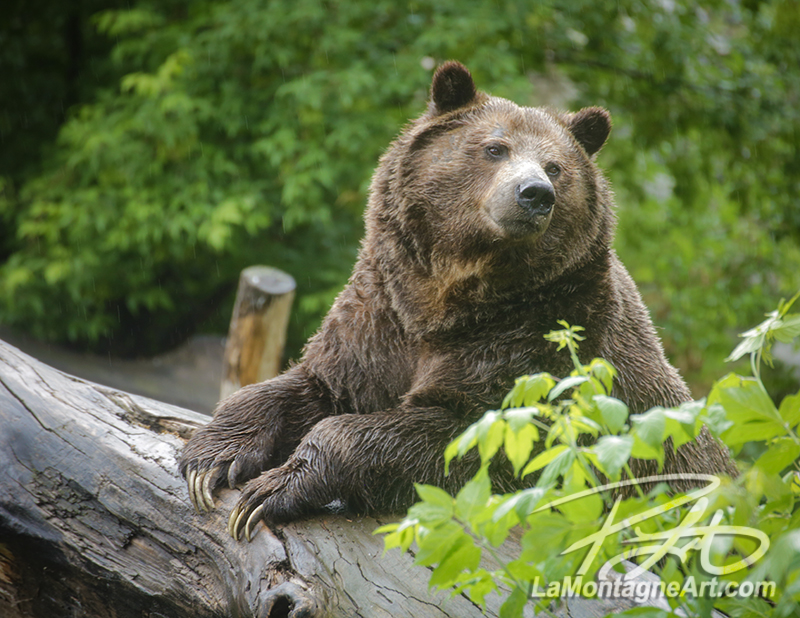 On Wednesday, I delivered a large print order to the Calgary Zoo. A zookeeper friend had ordered a couple of canvases, so I was also happy to deliver those to her.
On Wednesday, I delivered a large print order to the Calgary Zoo. A zookeeper friend had ordered a couple of canvases, so I was also happy to deliver those to her.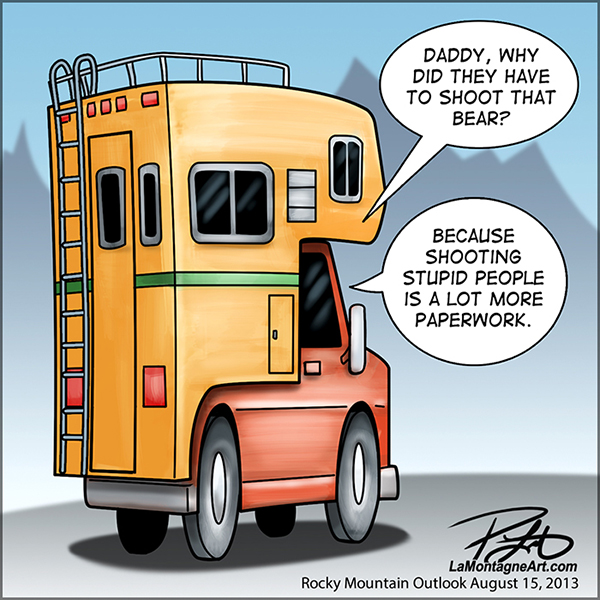 People leave food out while camping which attracts wildlife. When a bear associates people with food, it’s game over for the bear. I’ve lived in this valley for almost thirty years, and I don’t want to count how many times I’ve read about bears who’ve been euthanized because of selfish and careless people.
People leave food out while camping which attracts wildlife. When a bear associates people with food, it’s game over for the bear. I’ve lived in this valley for almost thirty years, and I don’t want to count how many times I’ve read about bears who’ve been euthanized because of selfish and careless people.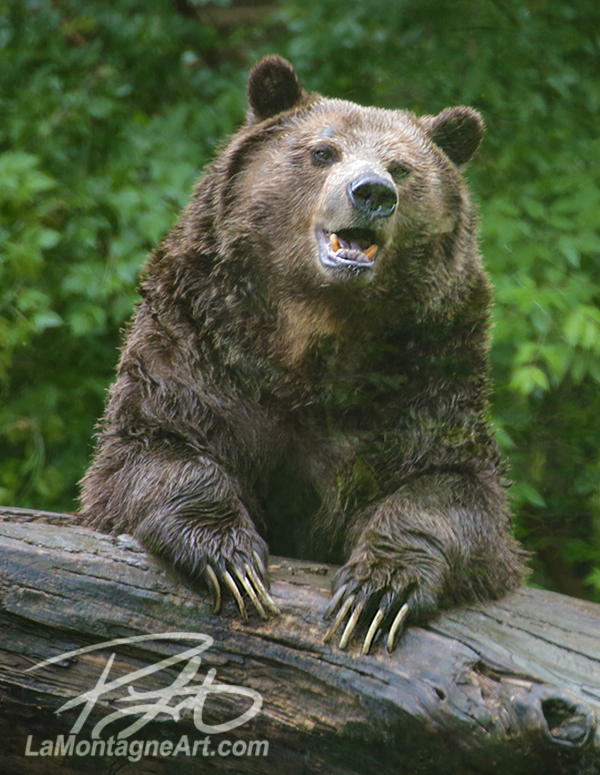 The more people repeat Skoki’s story, the more they educate young people to want to protect them in the wild and prevent them from being put in a zoo or destroyed.
The more people repeat Skoki’s story, the more they educate young people to want to protect them in the wild and prevent them from being put in a zoo or destroyed.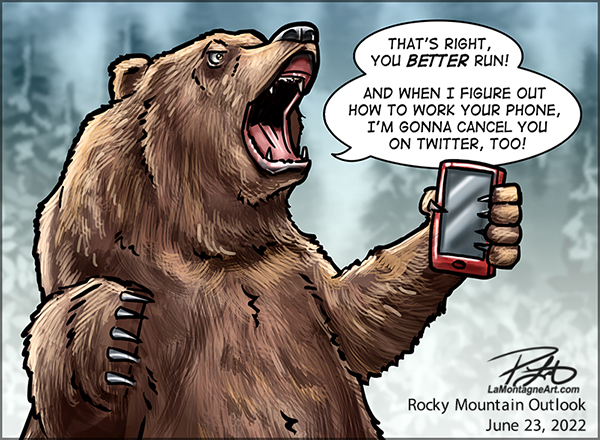 I must have taken about 700+ shots of Skoki on Wednesday. He gave me so many beautiful poses. At one point, he walked across a log, sat up and straddled it, then hung out there. The wind came up, and he was sniffing the air, clearly enjoying the rain, and I ended up with many great references. Look at those little feet.
I must have taken about 700+ shots of Skoki on Wednesday. He gave me so many beautiful poses. At one point, he walked across a log, sat up and straddled it, then hung out there. The wind came up, and he was sniffing the air, clearly enjoying the rain, and I ended up with many great references. Look at those little feet.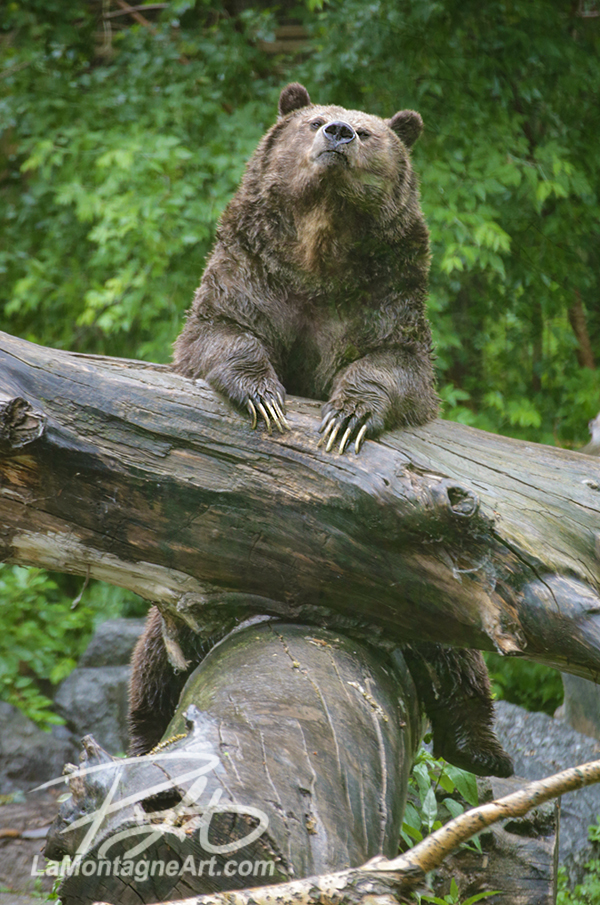 He gave me a great idea for a painting. I imagine several bears lined up at a log, like a bunch of friends hanging out at a bar. With his multiple poses and expressions in the same spot, I can paint five or six different bears using him as the reference. I’ll paint the faces and bodies differently for variety, making one thinner, another heavier, taller, and shorter; there are plenty of options. By varying the colours, the finished bears will look like their own characters, but the primary reference will still be one bear.
He gave me a great idea for a painting. I imagine several bears lined up at a log, like a bunch of friends hanging out at a bar. With his multiple poses and expressions in the same spot, I can paint five or six different bears using him as the reference. I’ll paint the faces and bodies differently for variety, making one thinner, another heavier, taller, and shorter; there are plenty of options. By varying the colours, the finished bears will look like their own characters, but the primary reference will still be one bear.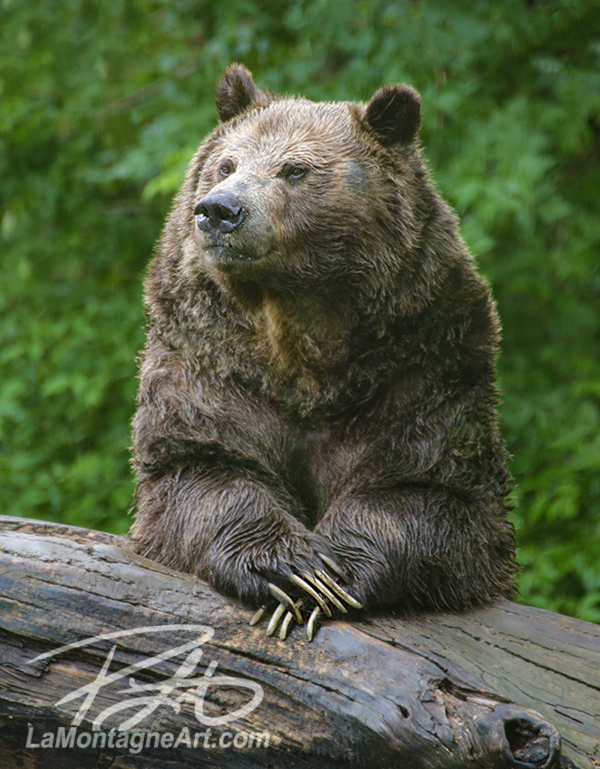 Resuming my walk back to my car about an hour and a half later, it struck me funny that I began the day hoping to get photos of animals I hadn’t yet painted or only painted once but left the zoo with a camera card full of grizzly bear photos. I have more pictures of bears than any other animal.
Resuming my walk back to my car about an hour and a half later, it struck me funny that I began the day hoping to get photos of animals I hadn’t yet painted or only painted once but left the zoo with a camera card full of grizzly bear photos. I have more pictures of bears than any other animal.

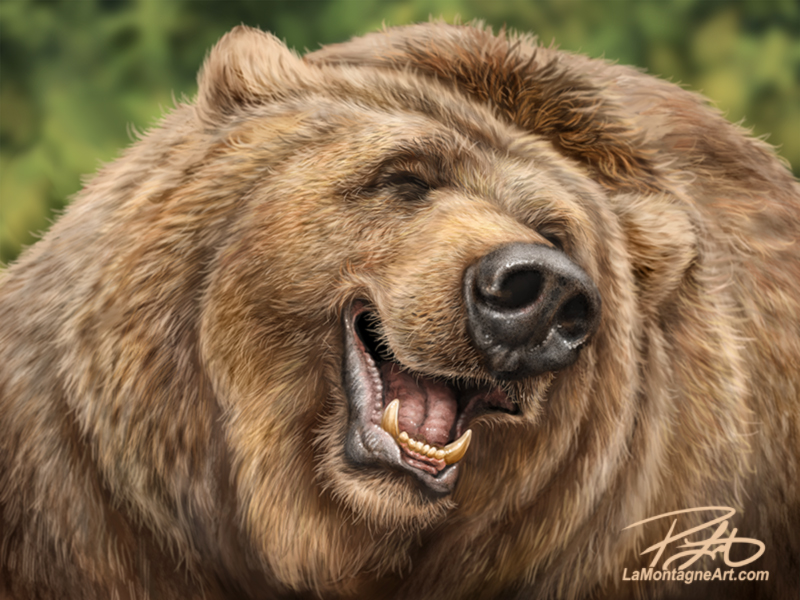 I’ve lost track of how many animals I’ve painted since that first grizzly bear in 2009, but I know it’s more than a hundred.
I’ve lost track of how many animals I’ve painted since that first grizzly bear in 2009, but I know it’s more than a hundred.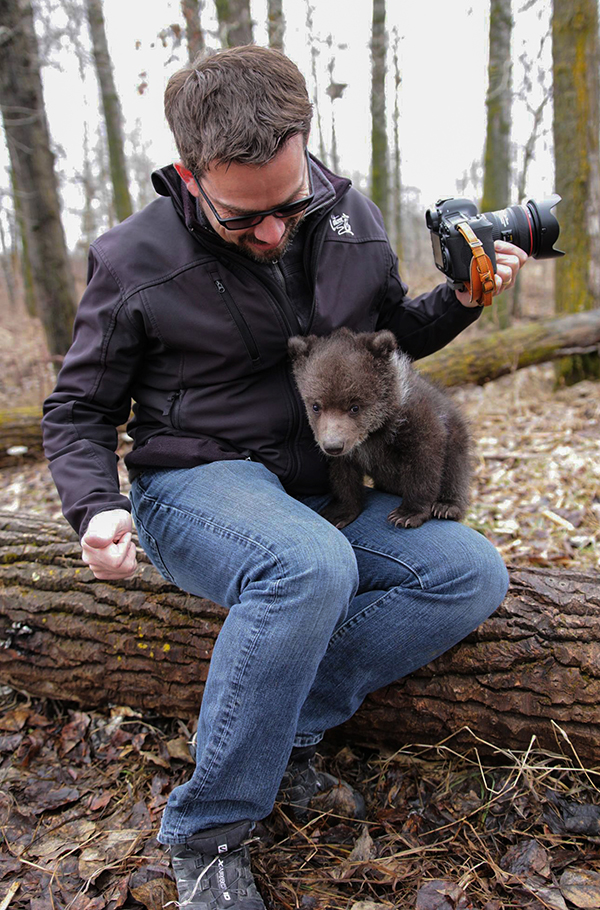 If you’ve followed my work for longer than five minutes, you’ll know all about her. An orphan rescued from the US in 2017 by my friend Serena at Discovery Wildlife Park in Innisfail, I’ve known Berkley since she was a few months old and have been painting her ever since. Here’s the first one.
If you’ve followed my work for longer than five minutes, you’ll know all about her. An orphan rescued from the US in 2017 by my friend Serena at Discovery Wildlife Park in Innisfail, I’ve known Berkley since she was a few months old and have been painting her ever since. Here’s the first one.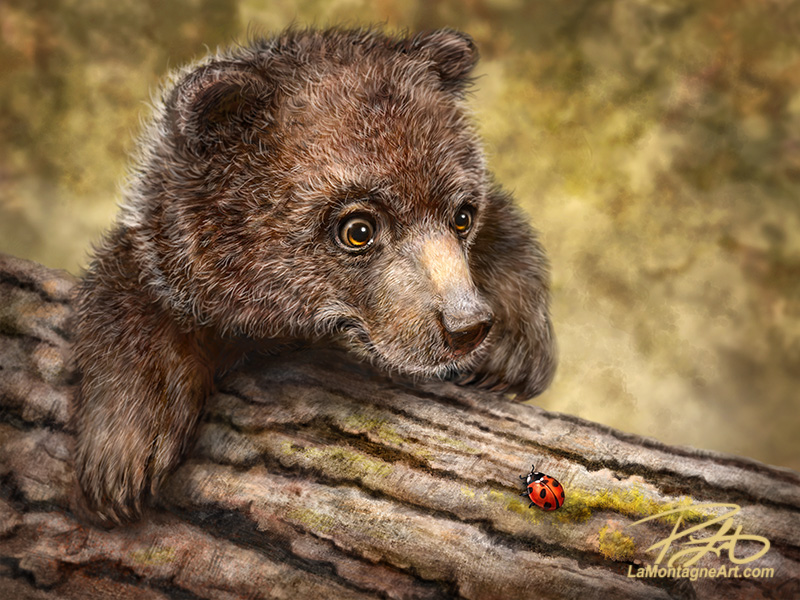
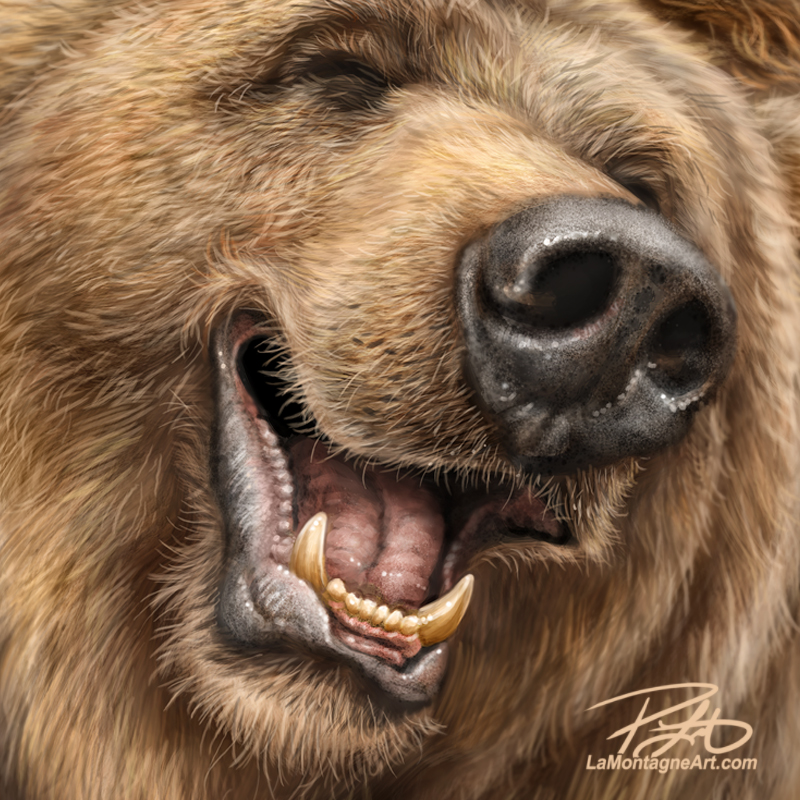 Serena regularly sends Shonna and I texts and photos of the animals, and we visit Discovery Wildlife Park as often as possible. Not so much the past few years, for obvious reasons, but I intend to change that once the warmer weather arrives.
Serena regularly sends Shonna and I texts and photos of the animals, and we visit Discovery Wildlife Park as often as possible. Not so much the past few years, for obvious reasons, but I intend to change that once the warmer weather arrives.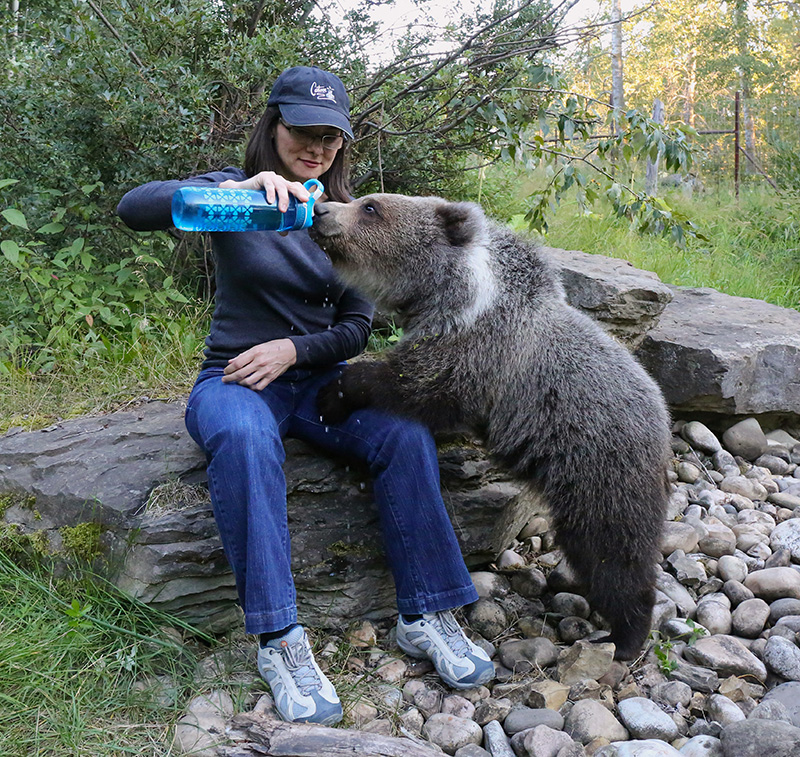 It’s a wonderful feeling that Berkley still knows me each visit and comes to say hello, no matter where she is in her large enclosure.
It’s a wonderful feeling that Berkley still knows me each visit and comes to say hello, no matter where she is in her large enclosure.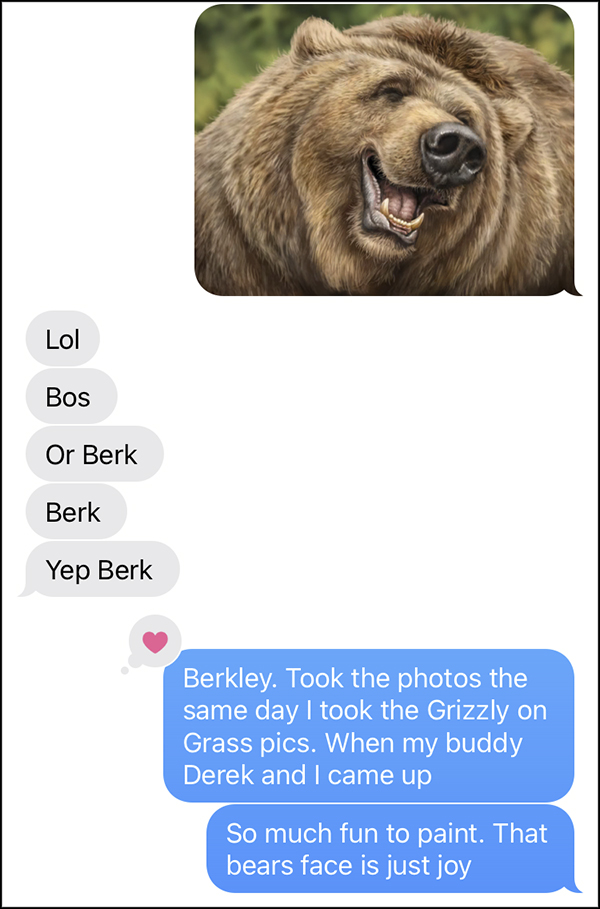
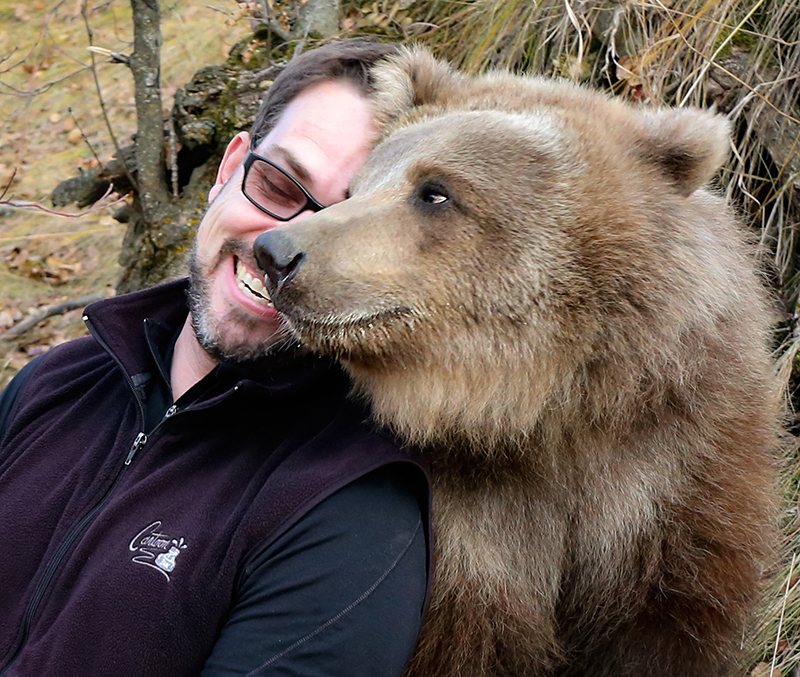

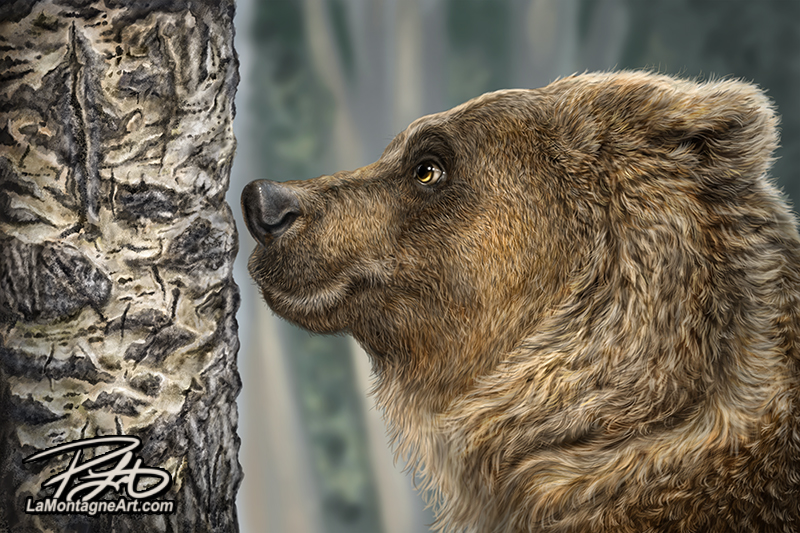 ____
____

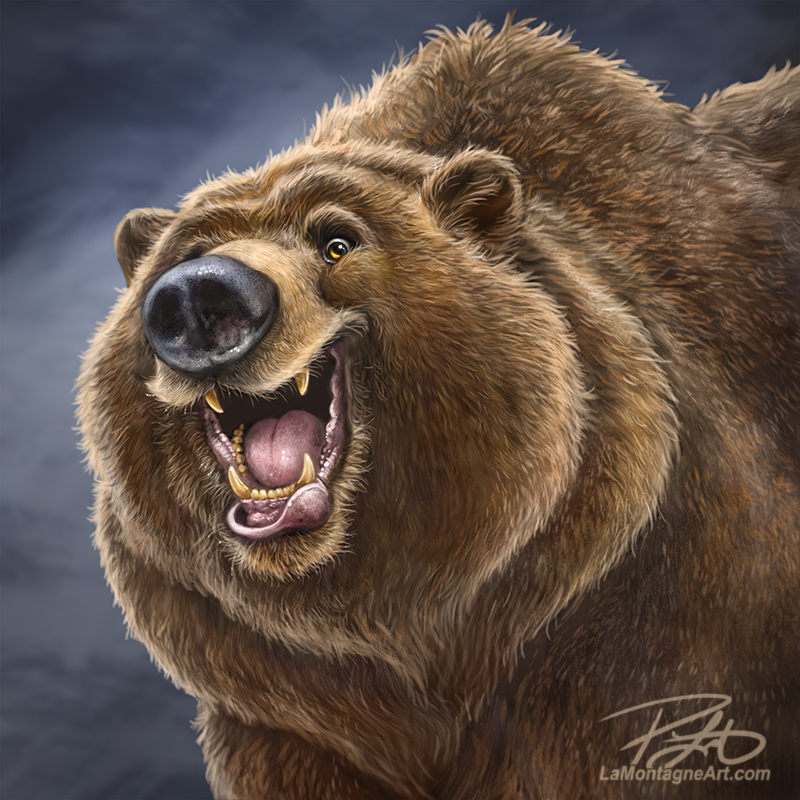 Part of living in bear country is knowing how to be safe when hiking or exploring. It’s important to learn how to react should you encounter a black bear or a grizzly in the woods, and sometimes even in your neighbourhood.
Part of living in bear country is knowing how to be safe when hiking or exploring. It’s important to learn how to react should you encounter a black bear or a grizzly in the woods, and sometimes even in your neighbourhood.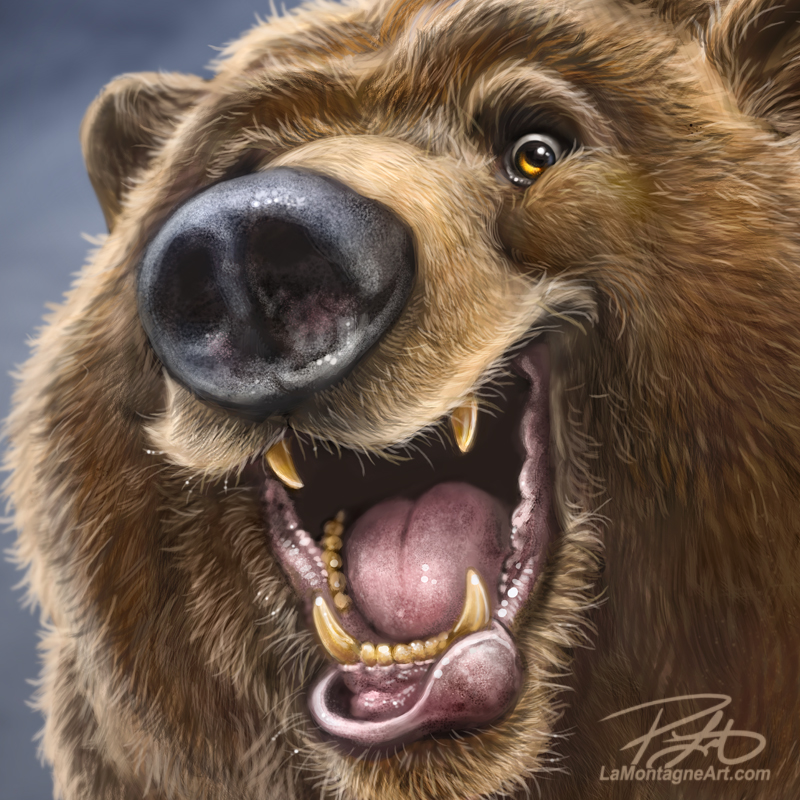 When it’s tough to get a group of people together for a hike, or you just don’t like that many people in the first place, you can sometimes identify solitary hikers by their familiar call of, “Hey Bear!”
When it’s tough to get a group of people together for a hike, or you just don’t like that many people in the first place, you can sometimes identify solitary hikers by their familiar call of, “Hey Bear!”